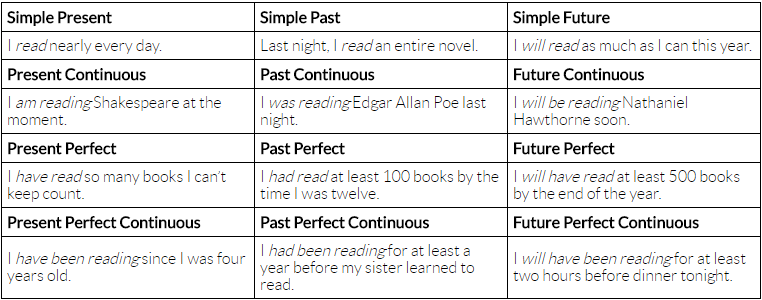Verb Tenses
Verb Tenses


Simple Present
The simple present is a verb tense with two main uses. We use the simple present tense when an action is happening right now, or when it happens regularly (or unceasingly, which is why it’s sometimes called present indefinite). Depending on the person, the simple present tense is formed by using the root form or by adding ‑s or ‑es to the end.
Example: I feel great! Pauline loves pie. I’m sorry to hear that you’re sick.
Typically, when we want to describe a temporary action that is currently in progress, we use the present continuous: Pauline can’t come to the phone right now because she is brushing her teeth.
How to Form the Simple Present
In the simple present, most regular verbs use the root form, except in the third-person singular (which ends in -s).
First-person singular: I write
Second-person singular: You write
Third-person singular: He/she/it writes (note the ‑s)
First-person plural: We write
Second-person plural: You write
Third-person plural: They write
For a few verbs, the third-person singular ends with -es instead of -s. Typically, these are verbs whose root form ends in o, ch, sh, th, ss, gh, or z.
First-person singular: I go
Second-person singular: You go
Third-person singular: He/she/it goes (note the ‑es)
First-person plural: We go
Second-person plural: You go
Third-person plural: They go
For most regular verbs, you put the negation of the verb before the verb, e.g. “She won’t go” or “I don’t smell anything.”
The verb to be is irregular:
First-person singular: I am
Second-person singular: You are
Third-person singular: He/she/it is
First-person plural: We are
Second-person plural: You are
Third-person plural: They are
How to Make the Simple Present Negative
The formula for making a simple present verb negative is do/does + not + [root form of verb]. You can also use the contraction don’t or doesn’t instead of do not or does not.
To make the verb to be negative, the formula is [to be] + not.
How to Ask a Question
The formula for asking a question in the simple present is do/does + [subject] + [root form of verb].
Common Verbs in the Simple Present
| Infinitive | I, You, We, They | He, She, It |
| to ask | ask / do not ask | asks / does not ask |
| to work | work / do not work | works / does not work |
| to call | call / do not call | calls / does not call |
| to use | use / do not use | uses / does not use |
| to have | have / do not have | has / does not have |
The Verb to Be in the Simple Present
| Infinitive | I | You, We, They | He, She, It |
| to be | am / am not | are / are not | is / is not |
